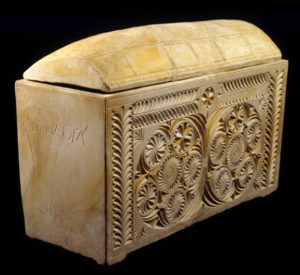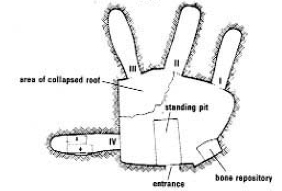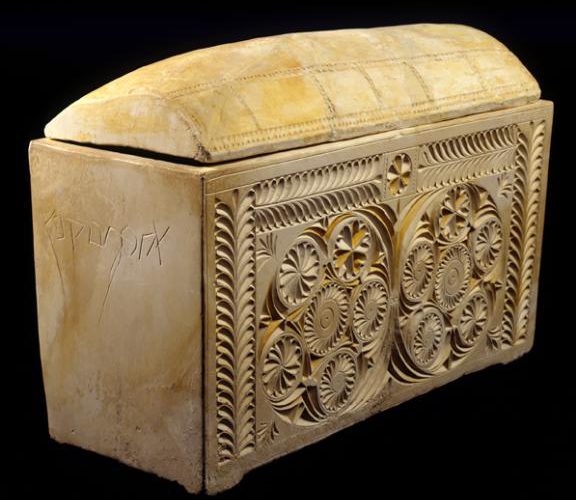The Nails That Dare Not Speak Their Name

The fact is that in 1990 a 1st century tomb was found in what is today Jerusalem’s “Peace Park”, in the area of Talpiot. The tomb contained twelve ossuaries, or bone boxes. Two of them are inscribed with a very rare family name “Qayafa” or “Caiaphas”. For those who forgot, Caiaphas is the man who the Gospels identify as the Jewish High Priest who sent Jesus to the Romans, who then sent him to the cross. For millennia, Caiaphas has been a lightning rod for anti-Semites and their actions.
Scholars generally agree that one of the inscribed ossuaries i.e., the ornate one, belongs to the High Priest mentioned in the Gospels. The ossuary is now on display in the Israel Museum. Since this is the only instance where a character from the Gospels has been identified archaeologically, you would think that Caiaphas’ tomb would now be a magnet for millions of visitors. Instead, it was paved over and a children’s park was built nearby. Put differently, it was literally covered up.

But what did they find in the tomb? Well, they found ossuaries, an oil lamp, a perfume bottle, a coin…and, oh yes, nearly forgot – two Roman nails! One of these nails was found inside an ossuary, the other on the ground next to the High Priest’s bone box. You would think that finding nails next to the man accused of nailing Jesus to the cross would raise some eyebrows…or even a little bit of interest, but no. Everything else in the tomb was photographed, drawn, measured and catalogued. As for the nails, well, under the watchful eye of archaeologist Zvi Greenhut, and his bone expert Joe Zias, they were…how should I put it…lost. Not only that, somehow no one had managed to photograph, draw, measure or even properly report the finding. It was mentioned in passing in the archaeological material as if the nails didn’t matter at all.
But what were Roman nails doing in the tomb of a Jewish High Priest? According to archeologist Ronny Reich, they were used to inscribe names on the sides of ossuaries. Since one of the nails was found inside one of the ossuaries, does Professor Reich’s theory make any sense? Do people really write names on their loved ones’ coffins and then toss the nails inside their skulls? But what other possible reason could there be for a nail to be inside a limestone coffin? According to Zias, they were used to secure the ossuary lids. I guess Zias never tried to drive a nail through limestone, which is essentially chalk. Maybe he’s been practicing nailing glass. In any event, the nails didn’t do a very good job securing the lid. One managed to slip under the lid and make its way among the bones of the deceased. Clearly, all this is nonsense.
Archaeologically speaking, we know why people were buried with nails. They were buried with nails because nails were amulets. They had magical powers. They helped the deceased in the afterlife. For example, as Professor Rachel Hachlili has noted, in a 5th century B.C.E. grave at Nicea, a dead man was found clutching six nails. At Olynthus nails were found in rows on either side of the upper part of the body of the deceased. Another magical use of nails was to pierce folded lead plaques inscribed with curses. All in all, nails buried for magical purposes have been found in Greece, Asia Minor, and Cyprus. Why would anybody in the pagan world be buried with a nail? According to the Roman historian Pliny (Natural History 28:11), nails can be powerful amulets if they are associated with crucifixion.
But what about nails in a 1st century Jewish context? Well, here too nails could act as amulets. Any nails? Not exactly. Only one kind of nail had magical powers: a nail used in a crucifixion.
This is not my idea. This is a documented fact. For example, in the Rabbinic literature (Mishna Shabbat 6.10, J. Talmud Shabbat 6:9, 7c-d, B. Talmud Shabbat, 67a) there is a discussion pertaining to the magical use of crucifixion nails for the purpose of healing. There, the sages say that the nails should not be used to heal people because the practice is associated with idolatry. As late as the 11th century, however, the Jewish philosopher, Maimonides, on his commentary on this tract, argues that they can be used and even carried on a Sabbath, in violation of the prohibition of carrying in a public place, if – and only if – the goal is to heal, and the activity is not associated with idolatry. In other words, in the Jewish tradition, crucifixion nails – nails that had been used to crucify someone – seem to have been associated with both healing and magic.
The passage in the Mishna, the earliest stratum of the Talmud, that discusses crucifixion nails and their amuletic/healing powers, has been often mistranslated and wrongly cited. This is what the Hebrew original literally says: “[Jews] are going about carrying the egg of a locust or a fox’s tooth, or the nail of the crucified one, for the purpose of healing, R. Meir said [allowed]. But other sages forbid this even on weekdays because it is considered the conduct of Amorites [i.e., gentiles].” In other words, in the Mishna, it’s the nail of “the crucified one” that has healing powers, not the nails of any crucified individual. It seems that in the Talmudic period nails associated with the crucifixion of Jesus were circulating in the Jewish community. For their part, the rabbis were torn between letting people use them for healing and concern that their use would lead to idolatry (see Masechet Avoda Zara 2:2, 40d).
But what about the Christian tradition? Is there any early tradition specifically referring to the nails that would have secured Jesus’ hands? In fact, there is. The non-canonical Gospel of Peter, dated to the 2nd century and discovered near Nag Hammadi, Egypt, in the late 1800’s, explicitly states that, as they were taking Jesus’ body of the cross; “they pulled the nails out of his hands” (chapter 6:21). The text then goes on to describe the burial of Jesus – without the nails. What happened to the nails? Were they preserved for amuletic purposes?
Given that Caiaphas is known to history for one thing only; the arrest, trial and crucifixion of Jesus, is it possible that the nails found in Caiaphas’s tomb were somehow implicated in the crucifixion of Jesus? Put simply, Caiaphas’ tomb has been found and Roman nails were found inside. According to pagan, Jewish and Christian traditions, a person would want to be buried with only one kind of nail – one involved in a crucifixion.
Faced with the textual references in Pliny, the Talmud, and the Gospel of Peter…knowing that nails have been found in pagan burials in Greece, Cyprus and Turkey, Israeli archaeologists removed the nails from Caiaphas’ tomb and promptly lost them. When I raised the matter in 2010, the response from academia and over 2 billion Christians was to ignore both the nails and their fate. Why is that?
Because Jews generally, and Israelis in particular, don’t understand that at its beginnings the Jesus movement was a Jewish phenomenon, they are not interested in exploring anything connected with the birth of Christianity. They don’t want to “Christianize” their past. For their part, Christians don’t want to explore the matter because they don’t want to find any archaeology that contradicts their theology. Meanwhile, academics don’t want to admit that they’ve missed some of the most important archaeological finds in history and people like Greenhut and Zias have to minimize the finds, so as to minimize their blunders.
As for everyone else, it seems that people in the Western world live in a kind of psychological box created by millennia of indoctrination perpetrated by the Church. According to this way of thinking, finding Caiaphas is possible, while finding anything connected to Jesus is impossible. Why? Because we’ve exiled Jesus from the realm of history, and placed him in the realm of mythology and theology.
But the fact is that Jesus’ crucifixion nails have been found – even if most scholars are too brainwashed to admit it.
Click here to see my recent article “Buying kidneys!” on The Times of Israel

